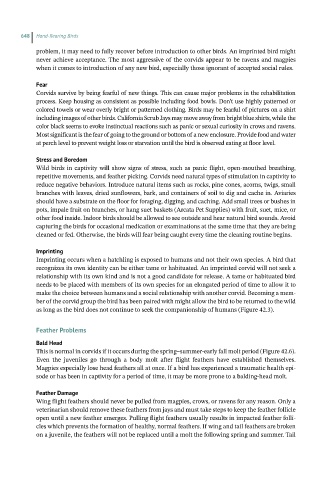Page 647 - Hand rearing birds second
P. 647
648 Hand-Rearing Birds
problem, it may need to fully recover before introduction to other birds. An imprinted bird might
never achieve acceptance. The most aggressive of the corvids appear to be ravens and magpies
when it comes to introduction of any new bird, especially those ignorant of accepted social rules.
Fear
Corvids survive by being fearful of new things. This can cause major problems in the rehabilitation
process. Keep housing as consistent as possible including food bowls. Don’t use highly patterned or
colored towels or wear overly bright or patterned clothing. Birds may be fearful of pictures on a shirt
including images of other birds. California Scrub Jays may move away from bright blue shirts, while the
color black seems to evoke instinctual reactions such as panic or sexual curiosity in crows and ravens.
Most significant is the fear of going to the ground or bottom of a new enclosure. Provide food and water
at perch level to prevent weight loss or starvation until the bird is observed eating at floor level.
Stressand Boredom
Wild birds in captivity will show signs of stress, such as panic flight, open-mouthed breathing,
repetitive movements, and feather picking. Corvids need natural types of stimulation in captivity to
reduce negative behaviors. Introduce natural items such as rocks, pine cones, acorns, twigs, small
branches with leaves, dried sunflowers, bark, and containers of soil to dig and cache in. Aviaries
should have a substrate on the floor for foraging, digging, and caching. Add small trees or bushes in
pots, impale fruit on branches, or hang suet baskets (Arcata Pet Supplies) with fruit, suet, mice, or
other food inside. Indoor birds should be allowed to see outside and hear natural bird sounds. Avoid
capturing the birds for occasional medication or examinations at the same time that they are being
cleaned or fed. Otherwise, the birds will fear being caught every time the cleaning routine begins.
Imprinting
Imprinting occurs when a hatchling is exposed to humans and not their own species. A bird that
recognizes its own identity can be either tame or habituated. An imprinted corvid will not seek a
relationship with its own kind and is not a good candidate for release. A tame or habituated bird
needs to be placed with members of its own species for an elongated period of time to allow it to
make the choice between humans and a social relationship with another corvid. Becoming a mem-
ber of the corvid group the bird has been paired with might allow the bird to be returned to the wild
as long as the bird does not continue to seek the companionship of humans (Figure 42.3).
FeatherProblems
Bald Head
This is normal in corvids if it occurs during the spring–summer-early fall molt period (Figure 42.6).
Even the juveniles go through a body molt after flight feathers have established themselves.
Magpies especially lose head feathers all at once. If a bird has experienced a traumatic health epi-
sode or has been in captivity for a period of time, it may be more prone to a balding-head molt.
Feather Damage
Wing flight feathers should never be pulled from magpies, crows, or ravens for any reason. Only a
veterinarian should remove these feathers from jays and must take steps to keep the feather follicle
open until a new feather emerges. Pulling flight feathers usually results in impacted feather folli-
cles which prevents the formation of healthy, normal feathers. If wing and tail feathers are broken
on a juvenile, the feathers will not be replaced until a molt the following spring and summer. Tail

